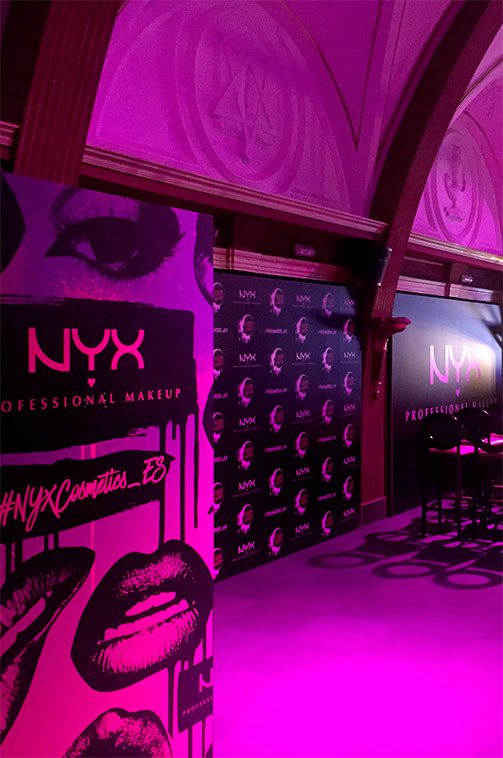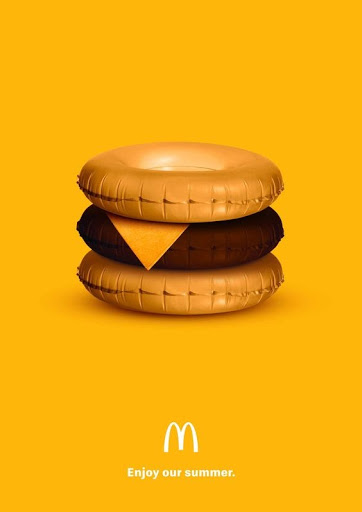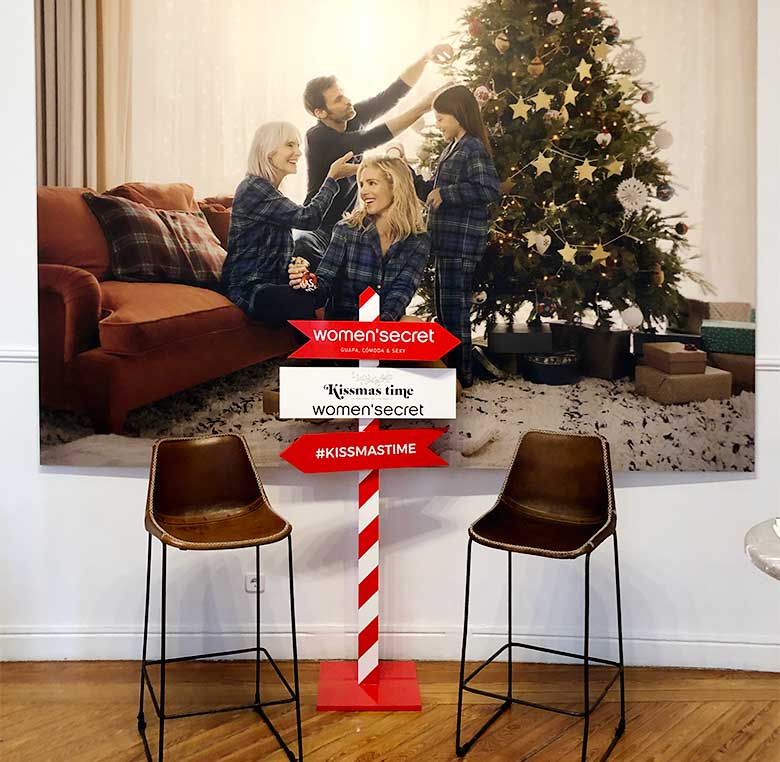
Today, graphic communication fills our lives; we encounter it in many situations as it is used by numerous brands, institutions, public services, and more to advertise and inform.
Attracting the attention of the receiver or informing them is fundamental; thanks to graphic elements such as images, illustrations, photographs, texts, or symbols, the message reaches the user more effectively and is easily understood.




NYX Face Awards Event, Madrid.
Good graphic communication helps us convey a message in an agile, straightforward, and effective manner. Due to these characteristics, it is becoming a widely used form of communication today—on the internet, on bus stops, in magazines, on TV, and on social media. All channels use graphic communication.
The most crucial aspect of graphic communication is the choice of colours, the design, the unification with the environment, and the transmission of data and emotions. It is essential to consider all these steps to convey the image you desire. Creativity plays a significant role in visual communication.
Knowing how important graphic communication is in our lives and within the commercial and communication world, this is an element that cannot be absent from any event, regardless of its nature. But first, we must distinguish between two terms related to graphic communication, which can sometimes create confusion.
Visual Communication: This is the transmission of ideas and information in forms that can be perceived wholly or partially with sight. Visual communication is usually presented or expressed in two-dimensional images and includes posters, typography, drawing, graphic design, illustration, industrial design, advertising, animation, colour, and electronic resources. It also encompasses the idea that text, when accompanied by a visual message, has greater power to inform or persuade a person or audience.
Graphic Design: This is the art, profession, and academic discipline whose activity consists of projecting visual communications intended to convey specific messages to social groups with determined objectives. Therefore, it is an interdisciplinary branch of design, whose foundations and objectives revolve around defining problems and determining objectives for decision-making through creativity, innovation, and lateral thinking along with digital tools, transforming them for proper interpretation. This activity helps optimise graphic communications. It is also known as communication design or visual design.
On the other hand, graphic design is not the same as graphic communication but is a part of it, specifically the creative and design aspect. Without good graphic design, graphic communication would not achieve the desired objectives.
This is why graphic communication and design come together to achieve the same goals, supporting each other. At an event, image and visual communication have a crucial function, as this will be responsible for conveying the message to the guests.
Using graphic communication brings many benefits that make it an essential tool for communication. Among others:
Instant Transmission: Very effective communication.
Ease of Understanding: One of the main advantages offered by graphic communication is simplicity.
Intercultural Communication: A graphic element removes language barriers in most situations.
Aesthetic Enjoyment: Graphic communication is related to graphic design, and therefore part of fulfilling its communicative function is that it is genuinely pleasing to the eye.
Apart from these, graphic communication offers other significant benefits for a brand and/or company.

The visual impact generated with good graphic communication is exceptional. When you combine a communication strategy with a creative graphic design, all visually, the result is incomparable.
We speak of a high visual impact when the recipient remembers us days later. When it comes to graphic communication, the recipient not only receives the message instantly and straightforwardly but also generates emotions and sensations that make the recipient want to know more about the message we convey; a new product, your brand, or a specific campaign.
In an event, image and communication are crucial, as the first impression you give at an event can position a guest in your favour or against you. In other words, as soon as you enter an event, one of the first things the guest encounters is your graphic communication, and this generates an opinion before seeing the rest of the space.
Designing visually impactful elements for the guest can create emotions and sensations from the first minute, making the guest enter the event with a positive disposition.
If, upon arrival, the guest sees a dull image, few graphic elements that attract them, colours that provoke nothing in them, they will generate a negative opinion after a few minutes at the event.
The good thing about graphic communication is that you can implement it in many situations, from a poster at the entrance to the bags you give the guest, allowing you to customise every detail of the event.
When we talk about graphic communication and advertising, we must discuss the discipline that unifies both tools: advertising graphic design.
Advertising graphic design is the branch of design that is responsible for creating visual content with intent. That is, besides designing, it inserts signs and symbols in its arts that convey ideas, messages, emotions, and even sensations.



Advertising graphic design is a communication channel between a brand or company and its audience. It allows you to connect and generate conversation with the recipient, create a feeling of empathy, desire to purchase, or any purpose you set for yourself.
But for an advertising graphic design action to be successful, a communication strategy must be planned, objectives must be monitored, and plans must be made when designing graphic elements and ensuring that the desired message is transmitted.
There are very famous brands known for their high level of advertising graphic design, which understand that their brand image is, ultimately, a powerful communication source with the customer. That is why they dedicate the necessary space within the company, and with dedication, planning, and creativity, we can enjoy posters like these.


A goal that all these posters fulfil is to create emotions and convey sensations to the customer. This aspect is significant in advertising, and thanks to graphic communication, you can make it possible.
Placing this type of graphic element at an event is crucial because we can send messages directly to the guest about a new product, the essence of our new campaign, or a new service in your brand. This will make the guest receive your message without even realising it.
An event is, in itself, a way to elevate your brand image; therefore, by showing a good image of it, it will be better positioned, and we will generate trust with our customer. The use of good graphic communication will help you showcase high visual impact images at your event.
Therefore, select your style and colours carefully, as you can create different sensations in your guests along with other elements. You can show that your brand is elegant, sophisticated, and luxurious. Or that your brand is youthful, creative, and fun. Everything depends on your image.


For example, the brand LOEWE, through its graphic communication, shows its minimalism and elegance with a touch of sophistication. Placing elements like these posters in their event space, in campaign videos, in bags, and brochures will help convey their image and what LOEWE is as a brand.
As you can see, they use neutral colours, black and white as the base of the design to convey their message. If these posters were very colourful, they might not convey the minimalist character they desire. Every detail is important.
With GUCCI, you will find colour, patterns, and since it is a luxury brand, a lot of customisation. This makes the guest satisfied with the image shown at the event when they see so many attractive graphic elements.
As you can see, the brand’s event image must align with the brand’s corporate image. A well-thought-out, creative image with surprising graphic elements and a communication strategy behind it will make your brand’s image at the event unbeatable.

As I have mentioned before, graphic communication allows us to create the image we desire at an event. This is very positive, so the customer feels satisfied with what they see and feel during the event’s development.
Apart from taking care of graphic communication, you must introduce details that create personalised attention, which is a plus that cannot be missing from any event today. This makes the customer feel special, more involved in the event, and part of it and your brand.
Details can include personalised gifts for your guest, decoration using brand graphic elements, such as on catering tables, graphic implementation depending on the area of the event, signage use, etc.
Also, taking care of the details shows that your brand is more complete and considerate and cares about the customer because the reality is that when we host an event, everything is directed toward the guest.
On the other hand, graphic communication helps us inform guests about issues related to the event, such as informational signs that indicate where the guest should go, what they will find in each event area, where they should sit, and the price of an item. But remember that all this should be done creatively and following your brand’s values.
When it comes to communicating graphically at an event, there are many tools and elements you can use. Here, I will highlight the most successful ones that you will easily find:
Photocall
This element is usually a staple at any event, whether it’s a fashion show, film premiere, music concert, or sports event, etc. It consists of a designated space where guests can stop to allow photographers to take pictures of them, or where they can take selfies. However, the real purpose of this tool is purely promotional, as it often features the names of brands collaborating with the event, the brand hosting the event, the name of a film, or a music band.
Thus, when these photos appear in the media or on social networks, your brand name will be clearly visible in the images. As mentioned, these photocalls usually feature brand logos, names, or some striking images, depending on the complexity of the design and what the event aims to achieve.

Rollup
This element has gained prominence in current advertising graphics. It is a portable self-retracting display, available in a versatile and durable format that is easy to set up and transport. The high-quality print of the Rollup has made it one of the star supports in graphic arts. They are perfect for advertising wherever you want, both outdoors and indoors.
It is a graphic support that communicates a message very visually, quickly, and easily, and can be adapted to all types of themes and functions. Its easy transportability is a beneficial characteristic that makes it a frequent choice for events or pop-ups.
This tool allows you to move it around the event, placing it in different zones, rolling it up, and storing it for another event without any complexity.

Banners
Banners are a fabric used for light boxes, posters, to be placed on a frame, etc. It requires robust material for its installation, capable of withstanding the tension of the banner. You can print any design on it, it can be various sizes, and you can place it in many different spaces since it is a very versatile material. It is quite an economical option, which is why many brands opt for it, and it is also easy to set up and take down.
It can also be backlit, allowing you to play with light to draw even more attention from your guests.
Vinyls
Vinyls are very economical, and you’ll find thousands of options in types and finishes. They can be printed in various sizes, which is why you can find them on bottles or in shop windows. This material is often used to personalise many elements. You will find vinyls in many shapes and colours, and their versatile nature is key to their use, making them perfect for implementation at events.


One thing to bear in mind is that the graphic elements you design for printing and placing at an event can also be adapted and used in the online aspect of the event, such as social media, websites, event announcements, etc. It’s a very comprehensive tool that you should give the attention it deserves to make a difference.
As you can see, graphic communication plays a significant role in an event. It helps you create the image you desire, convey feelings and emotions to the guest, and communicate your message in an easy, simple, and effective way.
Investing in graphic communication will ensure the success of your event.
You may also be interested
open
08:00 AM-18:00 PM Monday – Friday
08:00 AM-18:00 PM Monday – Friday